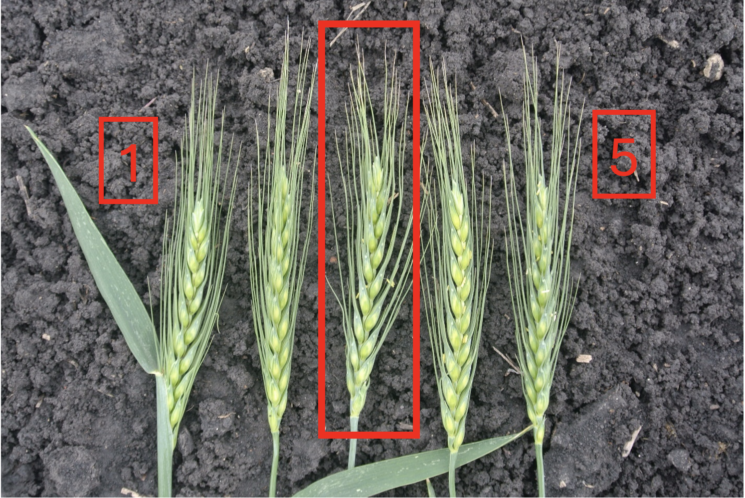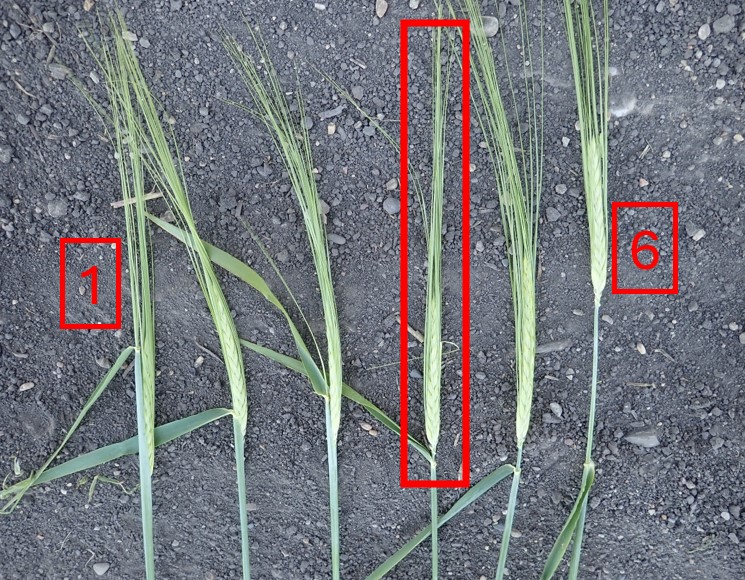Identifying heading and flowering growth stages in wheat and barley for FHB spray timing

Identifying wheat and barley growth stages is integral for proper application timing of crop protection products. Application timing of crop protection agents can strongly influence product effectiveness. This is no different for fungicide application timing for Fusarium head blight (FHB) suppression. Below are pictures that can help guide scouting efforts to determine crop stages, which can help you make informed fungicide application decisions.

In Figure 1 (above), growth stages range from late head emergence to multiple stages of flowering in spring wheat. Wheat is self-pollinating and begins to flower shortly after head emergence. Wheat head #3 (red box) is at the early flowering stage (GS 61). This is identified by anthers (yellow filaments) extruding from the middle to upper-middle portion of the wheat head only. Flowering moves both upwards and downwards along the wheat head until completion (spike #4 and #5). Flowering progression can move quickly depending on temperature. The degree of flowering will vary within a field; therefore, it is important to check 7-10 spots across a field when determining a crop’s growth stage. Click here for more information on spray timing and fungicide management for FHB.

In Figure 2 (above), the barley head outlined with the red box is at full head emergence, while barley heads #1 – #3 are still emerging. Barley flowers at a different growth stage compared to wheat. Barley flowers while in the boot and as the head emerges. This makes barley flowering difficult to identify. However, the optimal spray timing for FHB suppression differs between wheat and barley. Waiting until the majority of barley heads (70 – 100 per cent) on the main stem have fully emerged to three days post head emergence is the recommended spray timing for most fungicides approved for use on barley. (Always read and follow product labels and label directions. Refer to the Manitoba Guide to Field Crop Protection 2024 for more information.) Good coverage of the barley head is necessary for FHB suppression. Click here for more information on spray timing and fungicide management for FHB.
Information from Table 1 (below) was acquired from Table 3. Foliar Fungicides for Disease Control in Wheat and Barley in Manitoba’s Guide to Field Crop Protection 2024. Always refer to Manitoba’s Guide to Field Crop Protection and the product label before in-field application. As well, before fungicide application, review Keep it Clean to understand potential market access risk.
Table 1. Summary of products listed in Manitoba’s Guide to Field Crop Protection 2024 with suppression of FHB.
|
Product |
Crop |
Active Ingredient (Group) |
Page |
|
Advantage Prothioconazole 480 SC |
Wheat/Barley |
Prothioconazole (3) |
602 |
|
Advantage Prothio +Teb 250 EC |
Wheat/Barley |
Prothioconazole (3) + Tebuconazole (3) |
600 |
|
Advantage Tebuconazole 250 |
Wheat |
Tebuconazole (3) |
630 |
|
Bravo ZN / Bravo ZNC |
Wheat |
Chlorothalonil (M5) |
545 |
|
Caramba |
Wheat/Barley |
Metconazole (3) |
541 |
|
Echo NP/Echo 90WSP |
Wheat |
Chlorothalonil (M5) |
545 |
|
Folicur |
Wheat |
Tebuconazole (3) |
630 |
|
Holdfast |
Wheat/Barley |
Prothioconazole (3) |
602 |
|
Hornet 432 F |
Wheat |
Tebuconazole (3) |
630 |
|
Joust |
Wheat/Barley |
Prothioconazole (3) |
602 |
|
MIRAVIS Ace |
Wheat/Barley |
Pydiflumetofen (7) + propiconazole (3) |
578 |
|
Miravis Era |
Wheat/Barley |
Pydiflumetofen (7) + prothioconazole (3) |
581 |
|
Orius 430 SC |
Wheat |
Tebuconazole (3) |
630 |
|
Palliser |
Wheat |
Tebuconazole (3) |
630 |
|
Pavise 480SC |
Wheat/Barley |
Prothioconazole (3) |
602 |
|
Proline 480SC |
Wheat/Barley |
Prothioconazole (3) |
602 |
|
Prosaro PRO |
Wheat/Barley |
Prothioconazole (3) + Fluopyram (7) |
598 |
|
Prosaro XTR |
Wheat/Barley |
Prothioconazole (3) + Tebuconazole (3) |
600 |
|
Roxar |
Barley |
Tetraconazole (3) + Metconazole (3) |
622 |
|
Shalimar |
Wheat/Barley |
Prothioconazole (3) + Tebuconazole (3) |
600 |
|
Soraduo |
Wheat/Barley |
Prothioconazole (3) + Tebuconazole (3) |
600 |
|
Soratel |
Wheat/Barley |
Prothioconazole (3) |
602 |
|
Sphaerex |
Wheat/Barley |
Prothioconazole (3) + Metconazole (3) |
627 |
|
StarPro |
Wheat/Barley |
Prothioconazole (3) + Tebuconazole (3) |
600 |
|
Tebbie |
Wheat |
Tebuconazole (3) |
630 |
|
TILMOR 240 EC |
Wheat |
Prothioconazole (3) + Tebuconazole (3) |
633 |
|
Toledo 250EW |
Wheat |
Tebuconazole (3) |
630 |
|
Twinline* |
Wheat/Barley |
Pyraclostrobin (11) + Metconazole (3) |
637 |
|
VIKING Tebuconazole |
Wheat |
Tebuconazole (3) |
630 |
|
VIKING Tromso |
Wheat/Barley |
Prothioconazole (3) + Tebuconazole (3) |
600 |
Refer to product pages and labels for application information as well as expectations for control vs. suppression.
